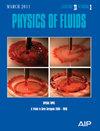恒定电压和阶跃电压下电液动力喷射打印的数值分析
IF 4.1
2区 工程技术
Q1 MECHANICS
引用次数: 12
摘要
电流体动力喷射打印是一种高效的微纳米三维制造技术。然而,由于液体变形和喷射背后复杂的电流体动力学机制,液滴一致性好、可控性好的打印工艺仍在研究中。本文对恒定电压和阶跃电压下的EHD喷射打印进行了数值分析。我们首先研究了基于恒压的脉冲EHD喷射打印,并解释了电压对制度、沉积液滴体积和三个关键打印阶段持续时间的影响,即锥体形成、喷射和喷射/半月板收缩和振荡。在此基础上,对不同电压阶跃变化下的EHD喷射打印进行了全面研究,重点研究了电压开关处和脱离泰勒锥后的喷射行为。借助数值数据得到的电场分布、界面电荷密度、速度场和非常清晰的液体运动图像,我们全面考察了脉冲打印过程,阐明了脉冲时间、偏置电压和峰值电压对打印行为、三个打印阶段的持续时间和沉积液滴体积的影响。最后,在得到结果的基础上,对两种技术的打印效果进行了比较。这项工作的发现可以用于推进对这一复杂但非常有用的制造技术的理解和控制方法。本文章由计算机程序翻译,如有差异,请以英文原文为准。
Numerical analysis of electrohydrodynamic jet printing under constant and step change of electric voltages
Electrohydrodynamic (EHD) jet printing is a highly effective technique for micro/nanoscale three-dimensional manufacturing. However, due to the complicated electrohydrodynamic mechanisms behind liquid deformation and jet emission, the printing process with remarkable droplet consistency and excellent controllability is still under investigation. In this work, a numerical analysis is conducted on EHD jet printing under constant and step change of electric voltages. We first examine constant-voltage-based pulsating EHD jet printing and explain the impacts of voltage on the regimes, deposited droplet volumes, and durations of the three key printing stages, namely cone formation, jetting, and jet/meniscus retraction and oscillation. After that, we carry out a comprehensive investigation on EHD jet printing under various step changes of voltages, while focusing on the jet behaviors at the voltage switch and after detaching from the Taylor cone. With the assistance of the electric field distribution, interface charge density, velocity fields, and very clear liquid motion images obtained from the numerical data, we fully inspect the pulsed printing processes and elucidate the influences of the pulse time, bias voltage, and peak voltage on the printing behaviors, durations of the three printing stages, and deposited droplet volumes. Finally, based on the obtained results, we make a comparison of the printing outcomes between these two techniques. The findings discovered in this work can be used for advancing the understanding and controlling methods of this complicated but very useful manufacturing technology.
求助全文
通过发布文献求助,成功后即可免费获取论文全文。
去求助
来源期刊

Physics of Fluids
物理-力学
CiteScore
6.50
自引率
41.30%
发文量
2063
审稿时长
2.6 months
期刊介绍:
Physics of Fluids (PoF) is a preeminent journal devoted to publishing original theoretical, computational, and experimental contributions to the understanding of the dynamics of gases, liquids, and complex or multiphase fluids. Topics published in PoF are diverse and reflect the most important subjects in fluid dynamics, including, but not limited to:
-Acoustics
-Aerospace and aeronautical flow
-Astrophysical flow
-Biofluid mechanics
-Cavitation and cavitating flows
-Combustion flows
-Complex fluids
-Compressible flow
-Computational fluid dynamics
-Contact lines
-Continuum mechanics
-Convection
-Cryogenic flow
-Droplets
-Electrical and magnetic effects in fluid flow
-Foam, bubble, and film mechanics
-Flow control
-Flow instability and transition
-Flow orientation and anisotropy
-Flows with other transport phenomena
-Flows with complex boundary conditions
-Flow visualization
-Fluid mechanics
-Fluid physical properties
-Fluid–structure interactions
-Free surface flows
-Geophysical flow
-Interfacial flow
-Knudsen flow
-Laminar flow
-Liquid crystals
-Mathematics of fluids
-Micro- and nanofluid mechanics
-Mixing
-Molecular theory
-Nanofluidics
-Particulate, multiphase, and granular flow
-Processing flows
-Relativistic fluid mechanics
-Rotating flows
-Shock wave phenomena
-Soft matter
-Stratified flows
-Supercritical fluids
-Superfluidity
-Thermodynamics of flow systems
-Transonic flow
-Turbulent flow
-Viscous and non-Newtonian flow
-Viscoelasticity
-Vortex dynamics
-Waves
 求助内容:
求助内容: 应助结果提醒方式:
应助结果提醒方式:


